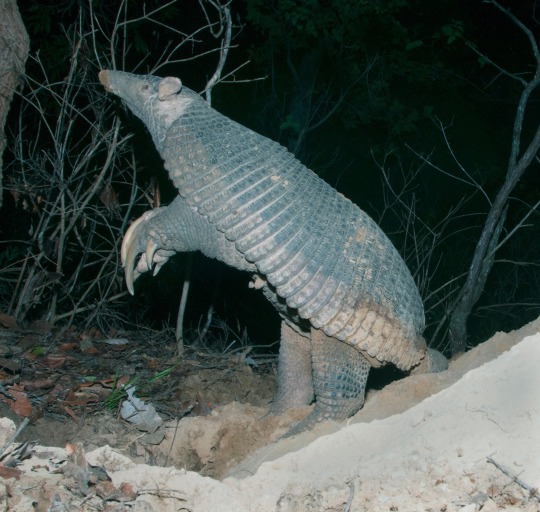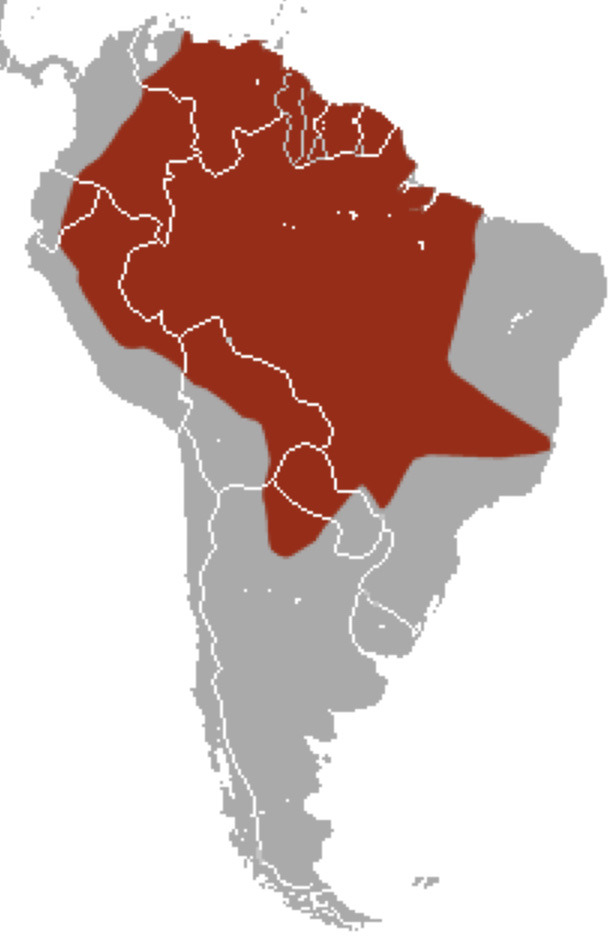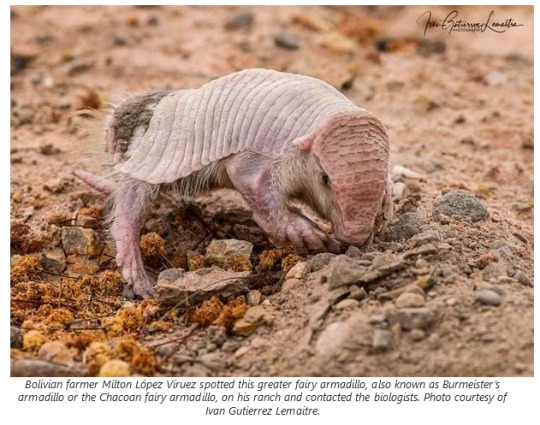#Chlamyphoridae
Text

Giant Armadillo (Priodontes maximus), family Chlamyphoridae, found in northern central South America
The largest species of armadillo, weighing up to 80 kg (180 lb), and reaching a length of up to 100 cm (39 in) (length w/o tail).
photograph by ICAS 2023
504 notes
·
View notes
Photo

Southern Three-Banded Armadillo (Tolypeutes matacus)
by Josh More
#southern three banded armadillo#Tolypeutes matacus#Tolypeutes#Chlamyphoridae#Cingulata#mammalia#chordata#captive animal#minnesota zoo#armadillos
42 notes
·
View notes
Text





Giant armadillo
Priodontes maximus
Family Chlamyphoridae, order Cingulata, superorder Xenarthra
Also known as the tatu-canastra, tatou, ocarro, and tatú carreta.
They prefer to eat termites and ants and will often consume the population of an entire termite mound. They also sometimes eat worms, larvae, spiders, snakes, carrion, and plants.
They are the largest extant (meaning not extinct) species of armadillo, usually weighing 18.7–32.5 kg (41–72 lb). There has been a wild specimen weighing 54 kg (119 lb) and a captive one weighing 80 kg (180 lb).
They are solitary and nocturnal. They spend the daytime in burrows.
Their burrows are very large, openings average at 43 cm (17 in) wide and typically face west.
These animals have not been studied much in the wild, but it has been discovered that many animals use their burrows. Dozens of animals, including the rare short eared dog, were observed using the same armadillo burrow in one day. They’re like, the construction workers of their area.
This animal is classified as vulnerable.
@jackalspine @fifiibibii
10 notes
·
View notes
Text
Uncharismatic Fact of the Day
How long can you hold your breath? Armadillos can hold theirs for up to 6 minutes! This is an important trait to have when most of their food is underground, and they have to dig to find it. It’s also given rise to many myths and folklore, including a fable in Paraguay that claims armadillos can easily walk along the bottom of rivers.

(Image: A giant armadillo (Priodontes maximus) searching for a midnight snack by Kevin Schafer)
If you like what I do, consider buying me a ko-fi!
69 notes
·
View notes
Photo

Six-banded armadillo (Euphractus sexcinctus)
Photo by Cláudio Dias Timm
#six banded armadillo#armadillo#euphractus sexcinctus#euphractus#euphractinae#chlamyphoridae#cingulata#xenarthra#atlantogenata#eutheria#mammalia#tetrapoda#vertebrata#chordata
26 notes
·
View notes
Photo

Pink Fairy Armadillo
Chlamyphorus truncatus
#pink fairy armadillo#fairy armadillo#armadillo#pink#tiny#mammal#mammalia#animal#animalia#digging#cingulata#chlamyphoridae#chlamyphorinae#wildlife#nature#cool#whoa#chlampyphorus truncatus
28 notes
·
View notes
Photo

Tatou - Cingulata #ambroisecharron #apo #apochrom #apochromat #nikond5 #nikon200 #nikon200mm #nikon200mmf2 #nikon200mmf2vr2 #tatou #tatoo #cingulata #chordata #mammalia #xenarthra #chlamyphoridae #dasypodidae #glyptodon #tatous https://www.instagram.com/p/B3TuW-tH5Uv/?igshid=matxpwn7ebgy
#ambroisecharron#apo#apochrom#apochromat#nikond5#nikon200#nikon200mm#nikon200mmf2#nikon200mmf2vr2#tatou#tatoo#cingulata#chordata#mammalia#xenarthra#chlamyphoridae#dasypodidae#glyptodon#tatous
0 notes
Photo

#Pink fairy armadillo#Chlamyphorus truncatus#animals#world#Chordata#Mammalia#Cingulata#Chlamyphoridae#Chlamyphorinae
1 note
·
View note
Photo

Glyptodon family with skull and tail armour/vertebra.
#glyptodon#armadillo#Xenarthra#xenarthran#cingulata#chlamyphoridae#pleistocene#painting#acrylic#canvas panel#I hope this doesn't end up on paleofail#sloyn#lsloyn
10 notes
·
View notes
Text
me: in the break room on phone, smiling widely, nodding with satisfaction, sighing
coworker: “what are you looking at???”
me:


They thought they might get stuck in the mud, but there was no thought of turning back. It would take another hour and a half to get to their destination. Giving up was not an option. They were after a holy grail of conservationists — a live sighting and registration of one of the rarest of the rare armadillos in the world, the elusive Chacoan fairy armadillo (Calyptophractus retusus), also known as the greater fairy armadillo, the mythical culotapado of local lore, or tatujeikurajoyava to the Guaranis of the Bolivian Chaco. Alternatively called tatu or coseberu by those in the cities, or “the cryer” by its 18th-century discoverers, it is also known to science as Burmeister’s armadillo. There was a lot of excitement. [...] Hearts were pounding with anticipation. [...] [T]he team was headed east, up Bolivia’s Highway 7, Doble Via La Guardia, toward the mining town of Camiri in the transition area between Amazonia and the Chaco dry forest. [...]
“There was no doubt, we had a culotapado,” said Bustillos, using the local name for the Chaco fairy armadillo, grateful to observe one of the rarest species in the world, alive. He explained how its back end appears to be sealed with a shield that keeps soil from sliding back as it digs down, and permits it to move and “swim” down at a 45-degree angle. [...] Bustillos said those were important observations of this unique animal, just fractions of an inch to an inch longer than its smaller cousin, the pink fairy armadillo of Argentina. It acts like a mole in its adaptations to subterranean life, said Bustillos, but instead of caving in search of food or escape, it submerges itself — swimming in the sand — and there it lives unnoticed. It is a species of armadillo in the family Chlamyphoridae. “It has a unique tail which he can use as a tripod,” Bustillos told Mongabay. No other armadillo has that use of its tail, he said. [...] What distinguishes the Chacoan fairy armadillo from other armadillos is that all others have a hard shell, Bustillos explained. This one has a soft shell, like skin [...]. “It was just a shock seeing such a strange naked pink-looking animal,” he added. “Huge claws for its size. Delicate looking. It makes a noise like a baby.” [...]
That noise was heard, by many of the first to see the peculiar little animal, as a cry of the [...] “duende,” the ghost-like pixie humanoid of South American myth, and so it is also called, “el lloron,” the crier. [...]
Closely related to anteaters and sloths, but not to the similar-in-appearance pangolins, armadillos range in color from the baby pink in Bustillos’s hands to the dark brown of the ‘tatou,’ as the giant armadillo is also known. [...] [T]here is a subtle but significant difference in the hue of the pink in this armadillo versus those of the same species found in the Gran Chaco itself [...]. The ones found in the Amazonian region are a baby pink color, like a pale salmon, he notes, while in the dry forest of the Chaco the same species is a darker, stronger, more vivid pink. [...] Encounters with the lighter-hued fairy armadillos in this area are still fewer -- just 12 registrations in the 161 years since 1859, making it the rarest of the rare. Underscoring the rarity of this find and the difference in appearance, Bustillos noted that after a 10-year intensive effort by the Wildlife Conservation Society in the Kaa-Iya del Gran Chaco National Park and Integrated Management Natural Area, Bolivia’s largest national park, the result was just 12 official registrations between 2000 and 2010. Only three have ever been registered in Argentina, and Paraguay registered eight in the period of 1959 to 2020 [...].

-------
Headline, images, captions, and text published by: Milan Sime Martinic. “Sighting of super rare Chacoan fairy armadillo in Bolivia ‘a dream come true’”. Mongabay. 21 December 2020. [Includes photos by Ivan Gutierrez Lemaitre, and commentary by field researcher Huascar Bustillos Cayoja.]
-------
Bonus round, involving the other species of fairy armadillo (Chlamyphorus truncatus, the pichiciego or pink fairy armadillo of Argentina):



411 notes
·
View notes
Text

Screaming Hairy Armadillo (Chaetophractus vellerosus), family Chlamyphoridae, order Cingulata, found in South-central SOuth America
photograph by Clyde Nishimura/Smithsonian's National Zoo
Listen to one here:
This Armadillo Screams So Loud | #shorts #armadillo (youtube.com)
#armadillo#hairy armadillo#chaetophractus#chlamyphoridae#cingulata#mammal#animals#nature#south america
901 notes
·
View notes
Text
So apparently glyptodonts are armadillos. They used to think they were a different but related family in the same superorder (Xenarthra), but then they did DNA analysis, and found they’re closer to the armadillos that are not in genus Dasypus than genus Dasypus are. So family Glyptodontidae was demoted to the subfamily Glyptodontinae, within the family Chlamyphoridae (non-Dasypus armadillos). And Dasypus was promoted to family Dasypodidae, containing only that one genus.
1 note
·
View note
Text
0 notes
Text
Armadillo (Dasypodidae) - Animals with Shields
Armadillo Animals with Shields Armadillo Scientific Name: Dasypodidae Armadillo Kingdom: Animalia Armadillo Phylum: Chordata Armadillo Class: Mammalia Armadillo Superorder: Xenarthra Armadillo Order: Cingulata Armadillo Families: Chlamyphoridae,Dasypodidae #armadillo #dasypodidae #animal
Watch video on YouTube: https://youtu.be/r55PzhYXGZE
0 notes
Photo

Tatou - Cingulata #tatou #tatoo #ambroisecharron #apochrom #nikond5 #nikon200500 #nikon200500mm #cingulata #dasypodidae #chlamyphoridae
#nikon200500mm#dasypodidae#tatoo#chlamyphoridae#apochrom#ambroisecharron#nikond5#cingulata#tatou#nikon200500
0 notes